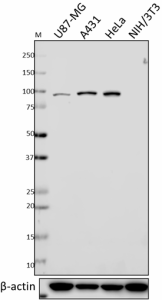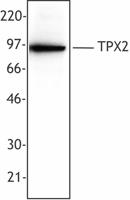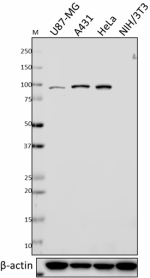- Clone
- 18D5 (See other available formats)
- Regulatory Status
- RUO
- Other Names
- Targeting protein for Xklp1, restricted expression proliferation associated protein p100, differentially expressed in cancer and non-cancerous lung cells 2 (DIL2)
- Isotype
- Mouse IgG1, κ

-

Total cell lysates (15 µg total protein) from U87-MG, A431, HeLa, and NIH/3T3 cells were resolved by 4-20% Tris-Gel electrophoresis, transferred to a nitrocellulose membrane, and probed with 1.0 µg/mL (1:500 dilution) of Purified anti-TPX2 Antibody, clone 18D5, overnight at 4°C. Proteins were visualized by chemiluminescence detection using HRP goat anti-mouse IgG Antibody (Cat. No. 405306) at a 1:3000 dilution. Direct-Blot™ HRP anti-β-Actin Antibody (Cat. No. 664804) was used as a loading control at a 1:5000 dilution (lower). -

MOLT-4 nuclear extracts were resolved by electrophoresis, transferred to nitrocellulose and probed with monoclonal anti-TPX2 (clone 18D5) antibody. Proteins were visualized using a goat anti-mouse secondary conjugated to HRP and a chemiluminescence detection system.
| Cat # | Size | Price | Quantity Check Availability | ||
|---|---|---|---|---|---|
| 628002 | 100 µg | $229.00 | |||
The TPX2 protein, also known as targeting protein for Xklp1, restricted expression proliferation associated protein p100, and differentially expressed in cancer and non-cancerous lung cells protein 2 (DIL2), is a 100 kD nuclear protein that contains two coiled-coil domains. The TPX2 protein is strictly associated with spindle pole and mitotic spindle during mitosis. In the G2/S position of the cell cycle, TPX2 is diffusely distributed throughout nucleus. TPX2 has been shown to be highly expressed in lung carcinomas cell lines, but not in normal lung tissues. TPX2 is thought to be required for the Ran-GTP dependent assembly of microtubules around chromosomes required to generate stable bipolar spindle with overlapping anti-parallel microtubule arrays and may also be involved in targeting Aurora-A kinase to the mitotic spindle. TPX2 has been shown to interact with a large number of proteins including serine/threonine protein kinase 6, ribosomal protein 6, Bop-1, α-tubulin, and nucleolin among others. TPX2 can be modified by phosphorylation on serine 738. The 18D5 monoclonal antibody recognizes human TPX2 and has been shown to be useful for Western blotting.
Product Details
- Verified Reactivity
- Human
- Antibody Type
- Monoclonal
- Host Species
- Mouse
- Immunogen
- Amino Acid: 1-220 of human TPX2
- Formulation
- This antibody is provided in phosphate-buffered solution, pH 7.2, containing 0.09% sodium azide at 0.5 mg/ml.
- Preparation
- The antibody was purified by affinity chromatography.
- Concentration
- 0.5 mg/ml
- Storage & Handling
- The antibody solution should be stored undiluted between 2°C and 8°C.
- Application
-
WB - Quality tested
ICC - Reported in the literature, not verified in house - Recommended Usage
-
Each lot of this antibody is quality control tested by Western blotting. For Western blotting, the suggested use of this reagent is 0.2 - 1.0 µg per ml. It is recommended that the reagent be titrated for optimal performance for each application.
-
Application References
(PubMed link indicates BioLegend citation) - Product Citations
-
- RRID
-
AB_2287863 (BioLegend Cat. No. 628002)
Antigen Details
- Structure
- Nuclear protein, contains two coiled-coil domains, approximately 100 kD
- Distribution
-
Nuclear, during mitosis strictly associated with spindle pole and mitotic spindle. In G2/S cell cycle, diffusely distributed throughout nucleus. Highly expressed in lung carcinomas cell lines, but not in normal lung tissues.
- Function
- This protein is exclusively expressed in proliferating cells from the G1/S transition to the end of cytokinesis. Thought to be required for the Ran-GTP dependent assembly of microtubules around chromosomes required to generate stable bipolar spindle with overlapping anti-parallel microtubule arrays. May also be involved in targeting Aurora-A kinase to spindle.
- Interaction
- Interacts with a large number of proteins including serine/threonine protein kinase 6, ribosomal protein 6, Bop-1,α-tubulin, and nucleolin among others
- Modification
- Phosphorylation (S738)
- Biology Area
- Cell Biology, Cell Cycle/DNA Replication
- Antigen References
-
1. Gruss OJ, et al. 2002. Nature Cell Biol. 4:871.
2. Heidebrecht HJ, et al. 1997. Blood 90:226.
3. Kufer TA, et al. 2002. J. Cell Biol. 158:617. - Gene ID
- 22974 View all products for this Gene ID
- UniProt
- View information about TPX2 on UniProt.org
Other Formats
View All TPX2 Reagents Request Custom Conjugation| Description | Clone | Applications |
|---|---|---|
| Purified anti-TPX2 | 18D5 | WB,ICC |
Compare Data Across All Formats
This data display is provided for general comparisons between formats.
Your actual data may vary due to variations in samples, target cells, instruments and their settings, staining conditions, and other factors.
If you need assistance with selecting the best format contact our expert technical support team.


